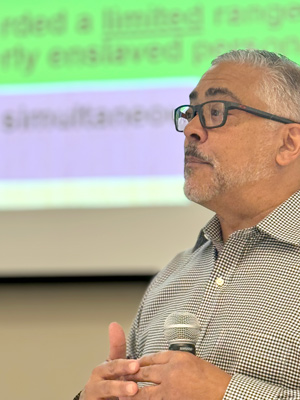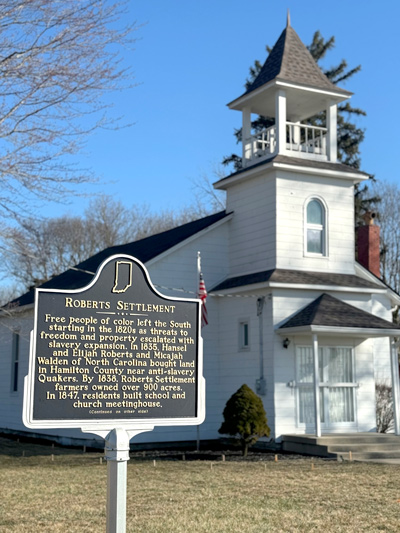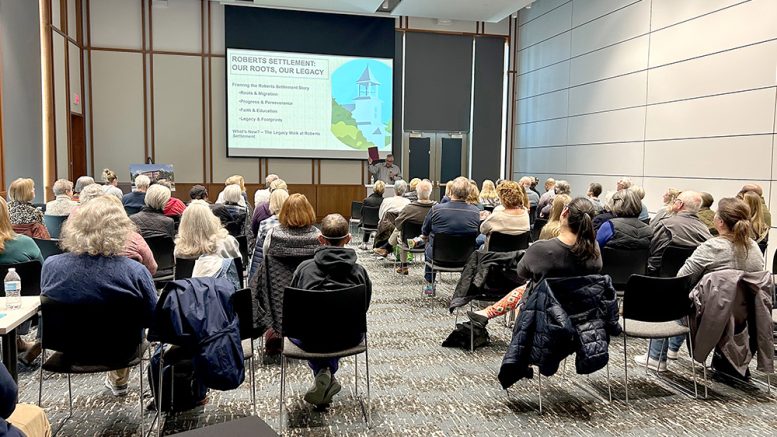By AMY ADAMS
news@readthereporter.com
As part of Black History Month, the Carmel Clay Historical Society hosted “Roberts Settlement: Our Roots, Our Legacy” on Friday, Feb. 23, at the Carmel Clay Public Library.
Roberts Settlement Vice President Bryan Glover spoke to a group of around 75, sharing the history of the community in northeastern Hamilton County founded by free black settlers in the 1830s.
“It’s wonderful to see a full house at these events,” said Elizabeth Hamilton, director of the Carmel Clay Public Library Foundation.
In 1835, Hansel Roberts, Elijah Roberts, and Micajah Walden made claims with the land office in Indianapolis and received grants for homesteads located in Jackson Township about three-quarters of a mile east of what is today the intersection of U.S. 31 and 276th Street.

Cyrus and Catherine Roberts and child, circa early 1900s. (Photo courtesy of Roberts Settlement)
While these three men are sometimes considered the “founders,” another 10 or so families purchased land nearby and joined them that same year.
“These families had commonalities,” Glover said. “All of them had originated in the same general area from North Carolina. They were free. They were mixed race people. It is believed they are descendants of white indentured mothers and black slave fathers.”
As time went on, early rights that free black men enjoyed began to be taken away, according to Glover – like the right to own a gun, testify in court, or to send their children to school.
“They were all in the same predicament,” Glover said. “Much like today, as with immigrants, they came to places where there were already people they knew.”
They also chose to settle near Quaker communities, like Westfield, because they knew it was a safer option.
“Even though the people who came to Roberts Settlement had not been enslaved, they still felt the result of discrimination,” Glover said. “Once they got beyond their borders and their neighboring friendly Quaker and Wesleyan communities, they certainly had doubts about how they were treated.”
Families with surnames like Brooks, Gilliam, Rice, Winburn, White, and others settled in the area and intermarried with the Roberts. A few families still live on the land, and other descendants live in the broader area of Hamilton County.
“It’s easier to say we are the Robertses, but, in fact, we are many families,” Glover said.
One of those descendants himself, Glover traces his direct line back to James Roberts, born in North Carolina in 1735.

Roberts Settlement Vice President Bryan Glover shares “Roberts Settlement: Our Roots, Our Legacy,” hosted by the Carmel Clay Historical Society. (Reporter photo by Amy Adams)
A Noblesville High School graduate, Glover worked in Los Angeles for years before moving back to his hometown in 2007 to become a local small business owner. He became more involved with Roberts Settlement amidst preparations for the Indiana bicentennial celebration in 2016 when Hamilton County Tourism President and CEO Brenda Myers reached out to him about including Roberts Settlement in the commemoration.
“That made me really dig into my history and really know my story,” Glover said.
By the 1870s, the Roberts Settlement covered nearly 2,000 acres and experienced a period Glover called “The Golden Years” – an era of progress with plenty of land for cultivation, as well as excess crops and excess livestock.
“They knew that education was the way,” Glover said. “They were running their own schools and made sure kids spent time learning every day, even before a public school was established.”
As the 1900s approached, young people from Roberts Settlement began taking their skills elsewhere in search of marriage partners and better opportunities. Descendants became doctors, lawyers, teachers, preachers, and public servants.
“The story of the Roberts Settlement families is a powerful example of determination,” said Debbie Gangstad, executive director of Carmel Clay Historical Society. “Against numerous odds, their ability to succeed and prosper through faith, education, and sometimes sheer grit was remarkable.”

Roberts Chapel was placed on the National Register of Historic Places in 1996. (Reporter photo by Amy Adams)
The Carmel Clay Historical Society and Carmel Clay Public Library took up a collection for Roberts Settlement after Glover’s presentation.
“I was blown away,” Glover said. “We’re a small organization.”
Future plans for Roberts Settlement include a Legacy Walkway to the side of the chapel. Funded by grants, donations, and the support of local businesses, the path will be open to the public and will allow visitors to take a walk through the area’s history.
“We recognize that everyone’s experiences weren’t exactly the same,” Glover said. “We try to tell the story of those who had this experience.”
Glover shares the heritage of Roberts Settlement as often as he can and said that he would like to establish more inroads into the schools in Hamilton County and would also like to engage with local teachers to learn how to shape their message for young people.
The Westfield Washington Historical Society will host Glover at 7 p.m. on Tuesday, April 16 at Westfield City Hall at 130 Penn St. For more information, go to RobertsSettlement.org.


As descendant of ancestors
Who established the Lost Creek settlement in Vigo County, Indiana.Thank you for your presentation.
Frederick C.Bullard